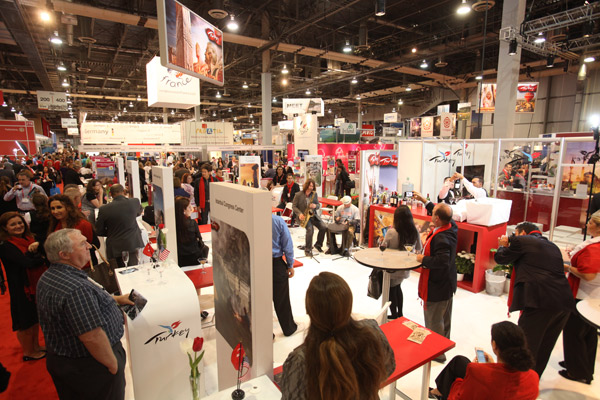The business travel, meetings and events industry continues to evolve, and 2013 will likely reflect some significant shifts that will influence where, when and how we meet in the future.
“While the economy has been a challenge in recent years, it seems that 2013 will begin to change that trend,” says Jorge Rubio Navarrio, consul for tourism affairs and director at the Tourist Office of Spain in Chicago. “For Spain, we saw a growth of 3% in 2012, in spite of the economic crisis. Similar growth is projected for 2013, with a good outlook for the business travel sector, thanks to Spain’s excellent infrastructures and industry professionals. The travel industry is positioning itself today to welcome greater numbers of international business travelers.”
Rubio’s observations about international business travel to Spain may be an excellent gauge that will help predict both the challenges and opportunities ahead. And it seems we have many other reasons to be optimistic about 2013 for business travel, meetings and events:
- We will travel more and meet globally.
- While the number of local meetings are expected to increase, more than one billion tourists traveled internationally in 2012, according to data from the World Tourism Organization (
- ), the United Nations specialized agency for sustainable tourism. December 13, 2012 was the symbolic day when this happened. Who was it? Unfortunately it wasn’t a business traveler, but it was a British tourist visiting Madrid — a celebration was held in her honor that day at the Museo del Prado. And if you’re not sure about the importance of this milestone, just compare it to 1990 when 450 million tourists traveled internationally.
- Where in the world will we meet in 2013?
Orlando, London, Shanghai and the Riviera Maya (Mexico) are likely to be top destinations for business meetings in their regions, according to the 2013 Global Meetings Forecast by American Express Meetings & Events. London should gain greater longer-term visibility by leveraging its Olympics legacy status to attract other major events and programs, starting this fall when Olympic Park will become available for private events. Other destinations that made the list include Las Vegas, Barcelona, Singapore and San Juan (Puerto Rico). Barcelona’s moderate winter climate and dedication to hospitality will always attract business travelers. And Singapore consistently appears as one of the top cities for international meetings, having a reputation for a high concentration of business and leisure activities. Other destinations on Business Travel Destinations’ watch list include (but are not limited to) Berlin, Madrid, Mexico City, New York City and Thailand.
- We will meet with greater purpose.
In my conversation with Mike Dominguez, senior vice president of sales for MGM Resorts last fall during IMEX America in Las Vegas, he explained that the way we meet today is completely different than how me met just five years ago. “Content and packaging needs to change, and it is changing,” Dominguez said, adding that there’s a shift toward meeting with key decision makers and suitable prospects. And he’s correct. At conventions, there’s a greater focus to incorporate one-on-one and small group meetings directly on the trade show floor. And for smaller meetings, there will be a greater focus on creating intimate experiences.
- We will continue to define the role of technology at the table.
For those who worry that we will replace live meetings with online meetings, this shouldn’t be a concern. Instead, the question in front of us is, how can we incorporate technology into meetings? Dominguez perceives technology as a social tool that enhances face-to-face. The vast majority of meetings are targeted to smaller groups to gather for business reasons. Business objectives will drive the decisions as to when and how we meet. With that in mind, it’s reasonable to project that technology will help build those communities through the use of social media, web meetings and video streaming. And this will continue to evolve for the next five years.
- We will incorporate wellness when on the road.
As they say, all work and no play… All kidding aside, wellness is a vital part of business meetings that was mischaracterized as simple indulgences in the past, but it really helps us to be more productive, explains Jennifer Lyn, spa director at Mandarin Oriental Las Vegas. This can certainly be achieved through a range of personal spa services and time in the fitness center, but wellness will continue to play a greater role in the program itself. Obvious ideas include mini-treatments between sessions, morning group walks and wellness topics that are part of the agenda. Less obvious but equally important is that meeting schedules will continue to evolve toward shorter and more interactive activities that will keep attendees moving. Catering will also reflect healthier options and a greater emphasis on more sustainable menus.
- We will define a greater role for DMCs.
Destination management companies (DMC) have grown from the ranks of ground transportation into their reputations today for serving as destination event experts, known for their ability to create unique experiences at unique venues. With the volume of destination information today, many meeting planners expect this, but are also requiring greater involvement from the DMCs they hire. Shaun Casey, regional director EMEA for Pacific World, a global DMC, says that he believes that DMCs will need to differentiate themselves by fully understanding the brand value of the client. “It’s our responsibility to understand the customer’s needs,” Casey said, adding that this means being dynamic and thinking outside the box. Just as many organizations are evolving their approach to meetings, successful DMCs will need to continue to evolve and transform themselves.
- Air fares in 2013 will remain reasonable, globally.
If your concern is the cost of air travel, this should be a good year to book flights. The price for local and long-haul air travel should stay flat or experience only a predictable increase in the low single digits, according to data from the Global Business Travel 2013 Forecast by American Express. And this is the case globally. Of course, this isn’t to say that business travelers and others shouldn’t keep a watchful eye on other hidden costs that drive up ticket prices, such as optional airline fees and taxes that seem to pile up. (See, 2013 Global Forecast for Air Fares and Hotel Rates for more details.)
- Hotel prices will rise in 2013, but this varies by location.
North America is where the cost of hotel rooms will increase the most. Due to the recession in recent years, hotel expansions have been limited in the U.S. While there will be a limited number of hotel rooms expected this year, Global Business Travel 2013 Forecast predicts increases of 2-7% in mid-range hotels and 4-9% in upper-range hotels. Outside the U.S., however, prices will be more attractive in comparison. For Europe, Middle East and Asia, negotiated rates will increase between 0.5% and 5% on average. And prices in Asia Pacific will fluctuate based on destination, but generally stay reasonable. What does this mean for international business travel and meetings? This is good news if you have programs planned in 2013 in Europe and Asia, and it should be even more favorable for these destinations in future years.
- Business travel, meetings and events will create results.
Live meetings, face-to-face meetings and live events are on the rise, according to IMEX Group, which runs two exhibitions — IMEX (Frankfurt, Germany) and IMEX America — for the international meetings, events and incentive travel industry. And demonstrating return on investment is a priority for meetings, trade shows and events, according to the Power of 10, an industry study released in October 2012 by IMEX. They’re not alone in this view. In its Global Business Travel 2013 Forecast, American Express acknowledged that “companies consider meetings and events to be a strategy to driving revenue growth and change management.” While this is certainly not a new idea, anytime the value of meetings is elevated to the attention of senior management, it should be seen as a good thing.
- Business meetings and events will contribute to the growth of travel industry jobs.
Travel and tourism is one of the world’s largest industries, supporting 255 million jobs and generating 9% of the world’s GDP, according to the World Travel & Tourism Council (WTTC). That’s huge — one in nine jobs on the planet. But there’s even better news: If you want a career in travel, chances are there will be new opportunities for you. For example, the U.S. Travel Association (USTA) is expecting 100,000 new travel jobs this year to meet the predicted growth in U.S. domestic and international demand.
Travel will to continue to expand annually between now and 2021. “We expect the direct contribution of Travel & Tourism to global GDP to grow by an average of 4% per annum between 2011 and 2021 with North East Asia making up a growing share of the overall travel and tourism contribution to GDP,” says David Scowsill, president and CEO of the WTTC.
Business travelers and meeting professionals will play a key role in that growth.
These trends comprise a pivotal turning point in business travel and events, and the leadership role that the industry plays in achieving organizational goals will gain more prominence this year. Through the collective voices of organizations such as the WTTC, UNWTO and USTA (among others), the industry will gain greater recognition for its favorable economic impact on local communities and countries around the world.
Interested in other 2013 predictions for meetings and events? Check out these reports:
Participating, Pricing, Political Prowess and Pursuit of Green





